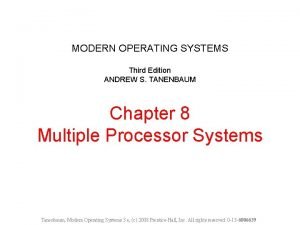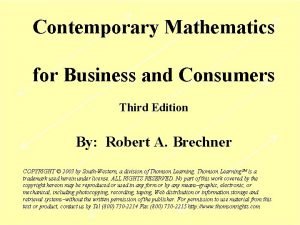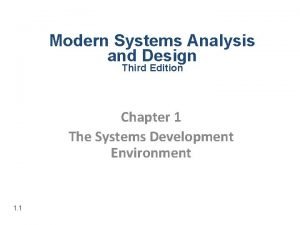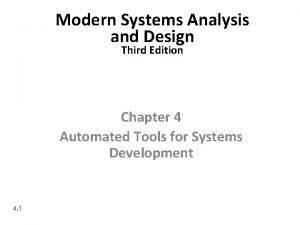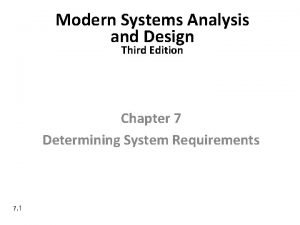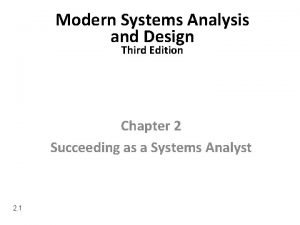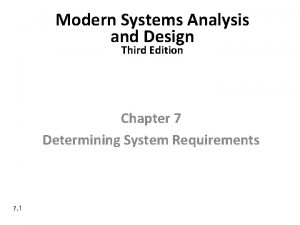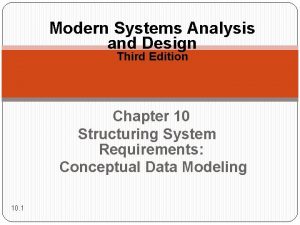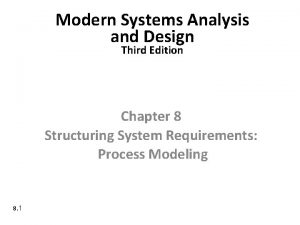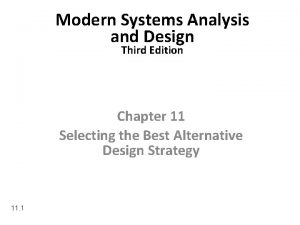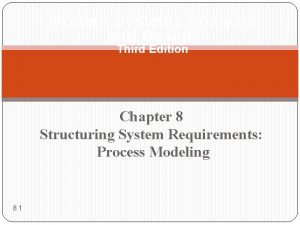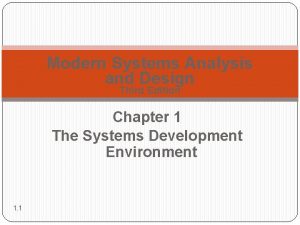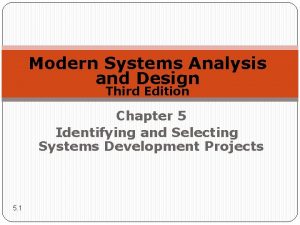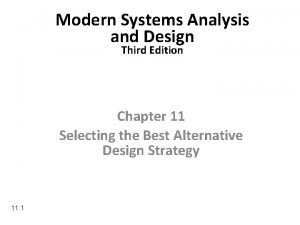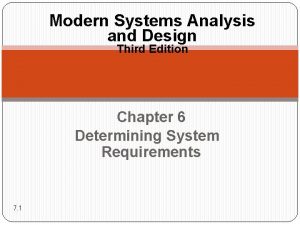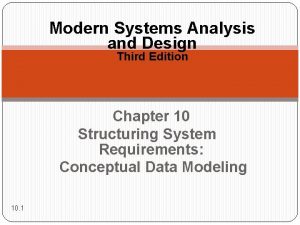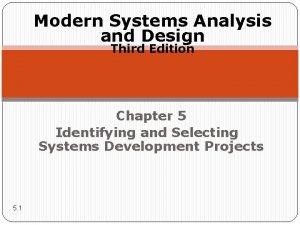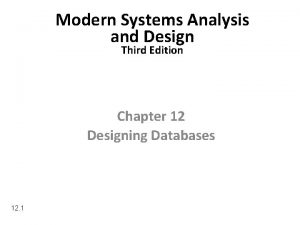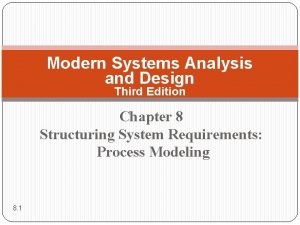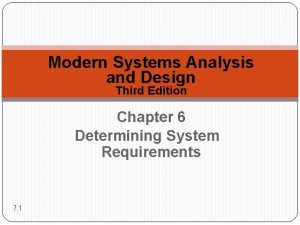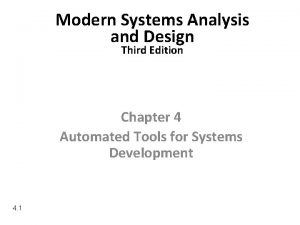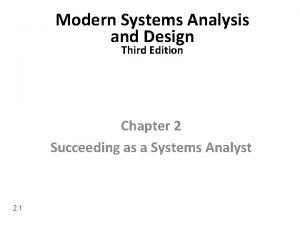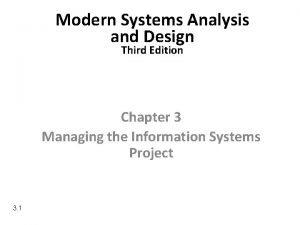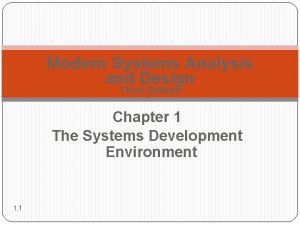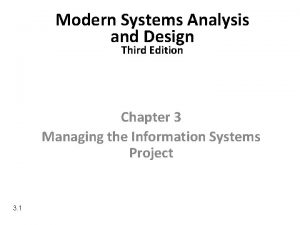Modern Systems Analysis and Design Third Edition Chapter

























- Slides: 25

Modern Systems Analysis and Design Third Edition Chapter 10 Structuring System Requirements: Conceptual Data Modeling 10. 1

Conceptual Data Modeling Process and logic modeling does not show the definition, structure and relationships within the data but show how, where, and when data are used or changed Most common format used for data modeling is entity-relationship (E-R) diagramming

Conceptual Data Modeling � Conceptual data model is a representation of organizational data � Purpose is to show as many rules about the meaning and interrelationships among data as are possible � Entity-Relationship (E-R) diagrams are commonly used to show data are organized � Main goal of conceptual data modeling is to create accurate E -R diagrams � Methods such as interviewing, questionnaires and JAD are used to collect information 10. 3

Deliverables and Outcomes � Primary deliverable is the entity-relationship diagram � There may be as many as four E-R diagrams produced analyzed during conceptual data modeling �An E-R diagram that covers just the data needed in the project’s application �An E-R diagram for system being replaced �An E-R diagram for the whole database from which the new application’s data is extracted �An E-R diagram for the whole database from which data for the application system being replaced is drawn 10. 4

Deliverables and Outcome Second deliverable is a set of entries about data objects to be stored in repository or project dictionary n n n Repository links data, process and logic models of an information system Data elements that are included in the DFD must appear in the data model and visa versa Each data store in a process model must relate to business objects represented in the data model

Figure 10 -3 Sample conceptual data model diagram 10. 6

Gathering Information for Conceptual Data Modeling Requirements Determination Questions for Data Modeling What are the subjects/objects of business? What type of people, places, things, events, etc. , are used or interact in business whose data must be maintained? How many instances of each object might exist? – data entities and their descriptions What unique characteristic (or characteristics) distinguishes each object from other objects of same type? Does this distinguish character change over time or is it permanent? – primary key What characteristics describe each object? On what basis are objects referenced, selected, sorted and categorized? – attributes and secondary keys How do you use this data? Are you the source of data, do you modify it or just refer it? Who is not permitted to use it? – security controls

Gathering Information for Conceptual Data Modeling Are all instances of each object the same? Are some objects summaries or combinations of more detailed objects – supertypes, subtypes, and aggregations What events occur that imply associations between various objects? – relationships and their cardinality and degree

Introduction to Entity-Relationship (E-R) Modeling � The basic E-R modeling notation uses three main constructs �Data entities �Relationships �Attributes Several different E-R notations exist but we use crow’s foot notations � Entity-Relationship Data Model (E-R model) �A detailed, logical representation of the data for an organization or for a business area �E-R model is expressed in terms of entities in business environment, the relationships or associations among those entities, and attributes or properties of both the entities and their relationships � Entity-Relationship Diagram (E-R diagram) 10. 9 �A graphical representation of an E-R model

Entity-Relationship (E-R) Modeling Key Terms � Entity � A person, place, object, event or concept in the user environment about which the organization maintains data � It has its own identity that distinguishes it from other entity � Examples – Person: EMPLOYEE, STUDENT, PATIENT Event: SALE, RENEWAL, REGISTRATION Object: MACHINE, AUTOMOBILE, BUILDING � Represented by a rectangle in E-R diagrams � Distinction between entity types and entity instances � Entity Type or Entity Class � A collection of entities that share common properties or characteristics � Each entity type is given a name � Use a simple noun to name an entity type – use capital letters � Name is placed inside rectangle representing entity � Entity Instance � It is a single occurrence of an entity type � An entity type can have many instances of that entity type represented by 10. 10 data stored in the database

Entity-Relationship (E-R) Modeling Key Terms � Attribute �A named property or characteristic of an entity that is of interest to an organization �Examples of entities and their associated attributes STUDENT: Student_ID, Student_Name, Student_Address, Major AUTOMOBILE: Vehicle_ID, Color, Weight, Power, Wheels �Attribute names are nouns with initial capital letter, followed by lowercase letters �Attributes are represented in E-R diagrams by an ellipse with name inside and a line connecting it to the associated entity

Entity-Relationship (E-R) Modeling Key Terms � Candidate keys and Identifiers �Each entity type must have an attribute or set of attributes that distinguishes one instance from other instances of the same type �Candidate key �Attribute (or combination of attributes) that uniquely identifies each instance of an entity type �Candidate key for STUDENT entity type may be Student_ID �Sometimes more than one attribute is needed to identify a unique entity �Some entities may have more than one candidate key �EMPLOYEE may have one candidate key Employee_ID or a combination of Employee_Name and Address 10. 12

Entity-Relationship (E-R) Modeling Key Terms � Identifier A candidate key that has been selected as the unique identifying characteristic for an entity type � Selection rules for an identifier 1. Choose a candidate key that will not change its value like Employee_Address 2. Choose a candidate key that will never be null 3. Avoid using intelligent keys whose structure indicates classifications, locations, and so on like first 2 digits of a key for a STUDENT entity might indicate college name 4. Consider substituting single value surrogate keys for large composite keys � The name of the identifier is underlined on an E-R diagram � 10. 13

Entity-Relationship (E-R) Modeling Key Terms � Multivalued Attribute �An attribute that may take on more than one value for each entity instance �A STUDENT can attend more than one class – multivalued attribute �Represented on E-R Diagram in two ways: �double-lined ellipse �weak entity – separate repeating data into another entity and then using relationship link it to its associated regular entity �Repeating group – several attributes that repeat together like EMPLOYEE Dependents – name, age, relation (spouse, child) � Relationships �An association between the instances of one or more entity types that is of interest to the organization �Association indicates that an event has occurred or that there is a natural link between entity types 10. 14 � Relationships are always labeled with verb phrase

Degree of Relationship � Degree �Number of entity types that participate in a relationship � Three cases �Unary �A relationship between two instances of one entity type (also 10. 15 called recursive relationship) �Binary �A relationship between the instances of two entity types �Ternary �A simultaneous relationship among the instances of three entity types �Not the same as three binary relationships �It is recommended that all ternary and higher relationships be represented as associative entities

Figure 10 -6 Example relationships of different degrees 10. 16

Cardinality � The number of instances of entity B that can be associated with each instance of entity A � Minimum Cardinality �The minimum number of instances of entity B that may be associated with each instance of entity A �If minimum cardinality of an entity is 0, then that entity is optional participant in relationship �If minimum cardinality of an entity is 1, then that entity is mandatory participant in relationship � Maximum Cardinality �The maximum number of instances of entity B that may be associated with each instance of entity A 10. 17


Naming and Defining Relationships � Relationship name is a verb phrase � Avoid vague names � Guidelines for defining relationships �Definition explains what action is being taken and why it is important �Give examples to clarify the action �Optional participation should be explained �Explain reasons for any explicit maximum cardinality �Explain any restrictions on participation in the relationship �Explain extent of the history that is kept in the relationship �Explain whether an entity instance involved in a relationship 10. 19 instance can transfer participation to another relationship instance

Representing Supertypes and Subtypes Often two or more entity types share common properties but also have one or more distinct attributes or relationships Subtype – a subgrouping of the entities in an entity types meaningful to an organization. Example – STUDENT is an entity type that has two subtypes GRADUATE STUDENT and UNDERGRADUATE STUDENT Supertype – a generic entity type that has a relationship with one or more subtypes Total specialization rule – each entity instance of the supertype must be a member of some subtype in the relationship (shown by double line) Partial specialization rule – an entity instance of the supertype is allowed not to belong to any subtype in the reationship (shown by single line) Disjoint rule – if an entity instance of the supertype is a member of one subtype, it cannot simultaneously be a member of any other subtype Overlap rule – an entity instance can simultaneously be a member of two or more subtypes. Disjoint is shown by a “d” and overlap is shown by a “o” in the circle

Business Rules The specifications that preserve the integrity of logical data model Four basic types of business rules: � Entity integrity – each instance of an entity type must have unique identifier that is not null � Referential integrity constraints – rules concerning the relationships between entity types � Domains – constraints on valid values for attributes � Triggering operations – other business rules to protect validity of attribute values Domains � The set of all data types and ranges of values that an attribute can assume – data type, length, format, range, allowable values, meaning � Several advantages 1. Verify that the values for an attribute are valid 2. Ensure that various data manipulation operations are logical 3. Help conserve effort in describing attribute characteristics 10. 21

Triggering Operations � An assertion or rule that governs the validity of data manipulation operations such as insert, update and delete � Scope of triggering operations may be limited to attributes with one entity or attributes of two or more entities � Includes the following components: �User rule �Statement of the business rule to be enforced by the trigger �Event �Data manipulation operation that initiates the operation �Entity Name �Name of entity being accessed or modified �Condition that causes the operation to be triggered �Action taken when the operation is triggered 10. 22

� Responsibility for data integrity lies within scope of database management system, not individual applications � Business rules should be documented in CASE repository so that rules would be checked automatically by database software The Role of CASE in Conceptual Data � CASE tools provide two important functions: �Maintain E-R diagrams as a visual depiction of structured data requirements �Link objects on E-R diagrams to corresponding descriptions in a repository 10. 23

� The real estate database contains an entity called PROPERTY, which is a property for sale by the agency. Each time a potential property buyer makes a purchase offer on a property, the agency records the date, offering price, and name of the person making the offer. A. Represent the PROPERTY entity and its purchase offer attributes using the notation for multivalued attributes. B. Represent the PROPERTY entity and its purchase offer attributes using two entity types. C. Finally, assume the agency decides to also keep data about buyers and potential buyers, including their name, address, and phone number. Augment your answer to part b to accommodate this new entity type.

Part a
 Modern systems analysis and design 7th edition
Modern systems analysis and design 7th edition Modern system analysis and design
Modern system analysis and design Modern systems analysis and design
Modern systems analysis and design A modern approach to systems analysis and design
A modern approach to systems analysis and design Distributed systems third edition
Distributed systems third edition Modern operating systems 3rd edition
Modern operating systems 3rd edition Structured computer organization
Structured computer organization Gj mount classification
Gj mount classification Forward caries and backward caries
Forward caries and backward caries 7 phases of the system development life cycle
7 phases of the system development life cycle Principles of economics third edition oxford pdf
Principles of economics third edition oxford pdf Organic chemistry (3rd) edition chapter 1 problem 20s
Organic chemistry (3rd) edition chapter 1 problem 20s Organic chemistry third edition david klein
Organic chemistry third edition david klein Business mathematics third edition
Business mathematics third edition Fundamentals of corporate finance third canadian edition
Fundamentals of corporate finance third canadian edition Fundamentals of corporate finance, third canadian edition
Fundamentals of corporate finance, third canadian edition Lifespan development third edition
Lifespan development third edition Lifespan development third edition
Lifespan development third edition Essential cell biology third edition
Essential cell biology third edition Joey's first 14 quiz grades in a marking period were
Joey's first 14 quiz grades in a marking period were Using mis (10th edition) 10th edition
Using mis (10th edition) 10th edition Report
Report Systems analysis & design in an age of options
Systems analysis & design in an age of options System analysis and design
System analysis and design Systems analysis and design in a changing world
Systems analysis and design in a changing world System analysis and design in a changing world
System analysis and design in a changing world




